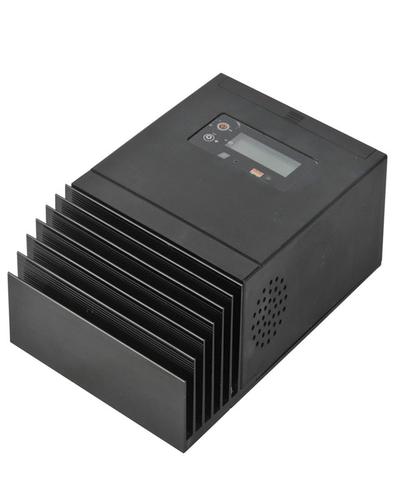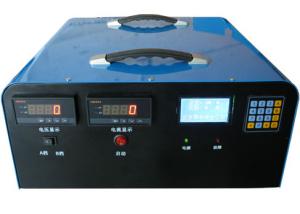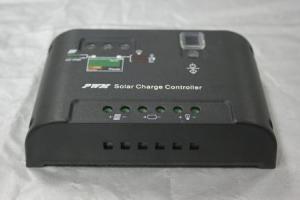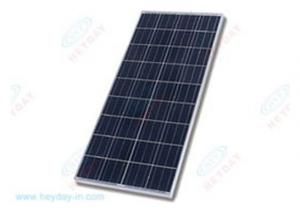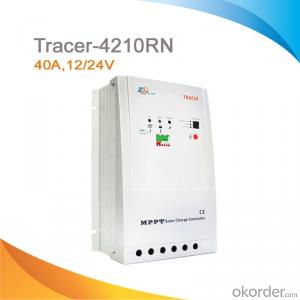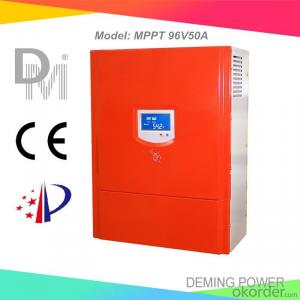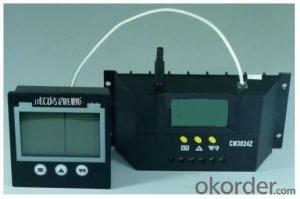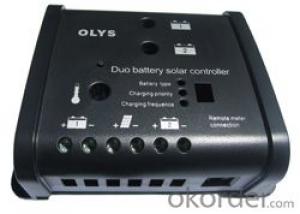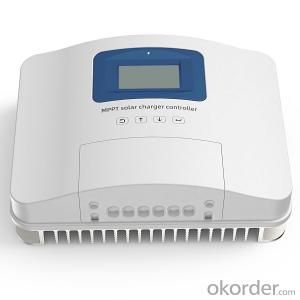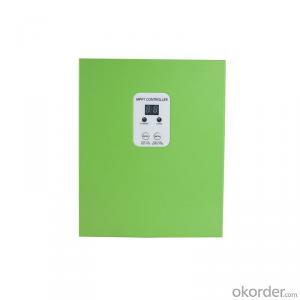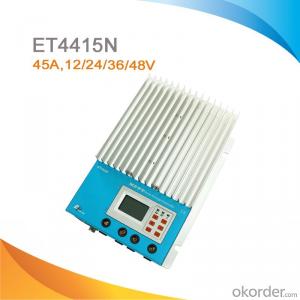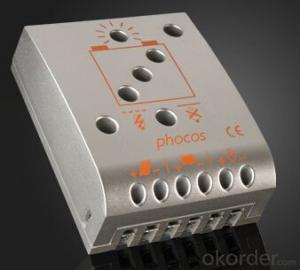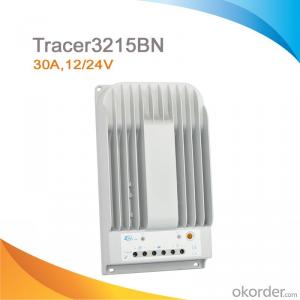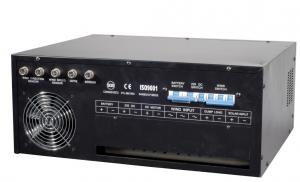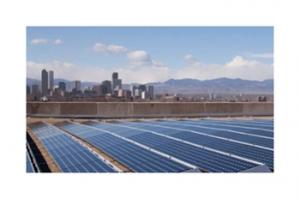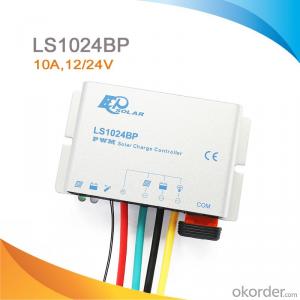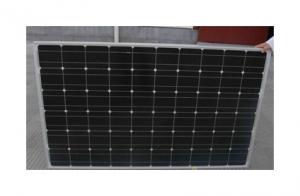SUN-MPPT-5015A Solar charge controller 50A
- Loading Port:
- Ningbo
- Payment Terms:
- TT or LC
- Min Order Qty:
- 20 pc
- Supply Capability:
- 10000 pc/month
OKorder Service Pledge
OKorder Financial Service
You Might Also Like
1. Overview
Thank you for selecting the MPPT solar charge controller.
The MPPT is essentially a smart DC to DC converter which has been optimized to harvest maximum energy from the PV array in battery based solar electric systems by using a variety of maximum power point tracking (MPPT) strategies.
The controller’s secondary objective is to ensure that the batteries receive a full charge without becoming overcharged.
This is accomplished through a four stage charging process.
Please take the time to read this operator’s manual and be familiar with the controller.
This will help you make full use of the many advantages the MPPT can provide for your PV system.
2. Features
1 - Battery Status LED Indicator:An LED indicator that shows battery status or system errors.
2 - Charging Status LED Insdicator:An LED indicator that shows charging status and overvoltage of pv.
3 - Setting Button1:Set load work mode,battery type and max charge current.
4 - Setting Button2:Set load work mode,battery type and max charge current(in manual mode used for load ON/OFF).
5 - LCD Digital Display:Dispaly the system status
6 - Wiring Box Cover:Sheet metal wiring box cover protects power connections
7 - FAN:FAN to dissipate Internal circuit heat
8 - Heatsink:Aluminum heatsink to dissipate controller heat
9 - Mounting Hanger:Keyhole slot for mounting
10 - Solar Module Terminals:Connect solar modules
11 - Battery Terminals:Connect batteries
12 - Load Terminals:Connect loads
13 - RJ45 Communication Interface:Communicate with personal computer
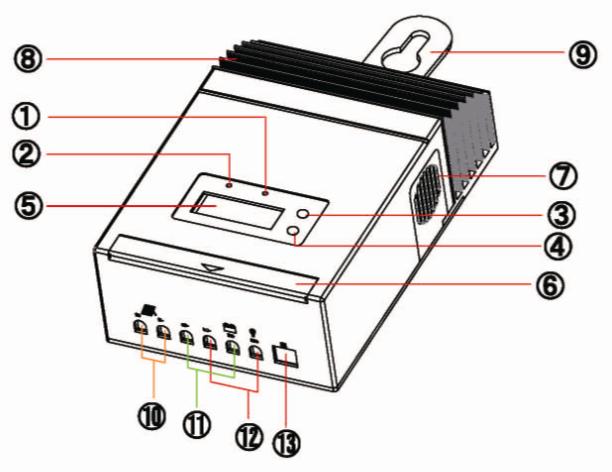
The mounting location is important to the performance and operating life of the controller. The environment must be dry and protected from water ingress. If required, the controller may be installed in a ventilated enclosure with sufficient air flow. Never install the MPPT unit in a sealed enclosure. The controller may be mounted in an enclosure with sealed batteries, but never with vented/ flooded batteries. Battery fumes from vented batteries will corrode and destroy the MPPT circuits. Multiple MPPT can be installed in parallel on the same battery bank to achieve higher charging current. Additional parallel controllers can also be added in the future. Each MPPT must have its own solar array.
CAUTION: Equipment Damage or Risk of Explosion
Never install the MPPT in an enclosure with vented/Flooded batteries. Battery fumes are fl ammable and will corrode and destroy the MPPT circuits.
CAUTION: Equipment Damage
When installing the MPPT in an enclosure, ensure suffi cient ventilation. Installation in a sealed enclosure will lead to over-heating and a decreased product lifetime.
NOTE : Mounting
When mounting the MPPT ,ensure free air through the controller heat sink fins. There should be at least 150mm of clearance above and below the controller to allow for cooling. If mounted in an enclosure, ventilation is highly recommended.
3. Specifications
Electrical

NOTE:
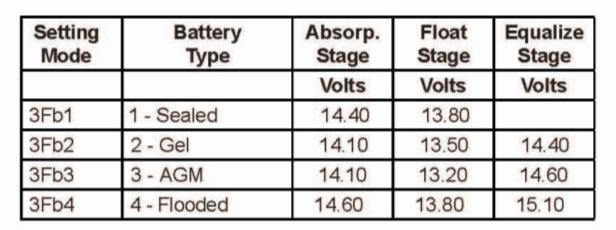
All charging voltage setpoints listed are for 12 Volt systems. Multiply 2X for 24 Volt systems.
Battery Charging Charging algorithm 4 - stage Charging stages Bulk, Absorption, Float, Equalize Temperature compensation coeffcient -5 mV / °C / cell (25 °C ref.) Temperature compensated setpoints Absorption, Float, Equalize, HVD Charging Setpoints
- Q: Can a solar controller be used with solar-powered agricultural equipment?
- Yes, a solar controller can be used with solar-powered agricultural equipment. A solar controller regulates and optimizes the charging and discharging of batteries in the solar system, ensuring efficient energy management. It is essential for controlling the flow of power from the solar panels to the equipment, protecting the batteries from overcharging, and extending their lifespan. Therefore, a solar controller plays a crucial role in the effective operation of solar-powered agricultural equipment.
- Q: Can a solar controller be used in an agricultural solar system?
- Yes, a solar controller can be used in an agricultural solar system. The solar controller helps regulate the charging and discharging of energy from the solar panels to the batteries, ensuring optimal performance and energy efficiency. In an agricultural solar system, the solar controller can effectively manage the power supply to various components such as irrigation systems, pumps, and lighting, helping to maximize productivity and sustainability.
- Q: Can a solar controller be used with solar panels of different mounting systems?
- Yes, a solar controller can be used with solar panels of different mounting systems. The solar controller's primary function is to regulate the charging and discharging of energy between the solar panels and the battery bank. It does not depend on the mounting system of the panels, but rather on the voltage and current output of the solar panels. As long as the solar panels are compatible with the solar controller's specifications, they can be used together regardless of the mounting system.
- Q: Can a solar controller be used in a solar-powered cruise ship?
- Yes, a solar controller can be used in a solar-powered cruise ship. A solar controller is an essential component in solar power systems as it regulates the charging and discharging of batteries, ensuring the efficient and safe operation of the system. In a solar-powered cruise ship, the solar controller would be used to manage the energy flow from the solar panels to the batteries, ensuring optimal power generation and storage.
- Q: Can a solar controller handle different load types (e.g., resistive, inductive)?
- Yes, a solar controller can handle different load types including resistive and inductive loads. A solar controller is designed to regulate and control the flow of electricity from solar panels to the connected devices or loads. It is typically equipped with various protection mechanisms and adjustable settings to accommodate different load types and ensure efficient power delivery.
- Q: What is the role of a solar controller in preventing battery overcharging?
- To prevent battery overcharging, the flow of electricity from the solar panels to the battery bank is regulated by a solar controller. When sunlight hits the solar panels, they produce electricity, which must be carefully managed to avoid overcharging the batteries. Acting as an intermediary, the solar controller, also referred to as a charge controller, monitors the voltage and current levels from the solar panels. It then adjusts these levels based on the battery's charge status. When the batteries reach full capacity, the solar controller restricts or completely stops the electricity flow from the panels to prevent overcharging. Overcharging the batteries can result in negative consequences such as decreased battery life, heightened maintenance needs, and potential safety hazards like explosions or fires. By preventing overcharging, the solar controller promotes the longevity and efficient operation of the batteries. Moreover, the solar controller may include additional features like temperature compensation. This feature adjusts the charging voltage based on the battery's temperature, further optimizing the batteries' performance and lifespan. In conclusion, the solar controller's main role in preventing battery overcharging is to regulate the flow of electricity from the solar panels to the batteries. This ensures the batteries are charged in the best and safest way possible.
- Q: What is the power of the solar controller?
- For example: 12V10A controller, then the solar panel over the current is not more than 10A, the solar panel power is not more than 120W, useful DC load, then the DC load is not more than 80W
- Q: Can a solar controller be used with solar-powered indoor sports facilities?
- Solar-powered indoor sports facilities can indeed utilize a solar controller. This device serves to regulate the flow of electricity from the solar panels to the battery bank, efficiently charging the batteries and preventing overcharging or undercharging. To harness sunlight and convert it into electricity, solar panels can be installed on the roof or in a nearby location of these facilities. The solar controller will then oversee the charging process, guaranteeing optimal battery charging. Given that indoor sports facilities require a substantial amount of electricity to power various equipment, lighting, and ventilation systems, incorporating solar power allows for reduced reliance on the grid and lower energy costs. Additionally, solar power aligns with sustainability goals and reduces the facility's carbon footprint as it is a clean and renewable energy source. The solar controller will constantly monitor the battery voltage and adjust the charging current to maintain the batteries at their optimal voltage levels. It also protects the batteries by preventing overcharging, which can lead to reduced battery lifespan or damage. Furthermore, the solar controller can offer valuable data and insights regarding the energy production and consumption of the indoor sports facility. This information can be utilized to optimize energy usage, identify areas for improvement, and potentially implement energy-saving measures. To summarize, a solar controller effectively regulates the charging process in solar-powered indoor sports facilities, ensuring optimal battery performance and maximizing the utilization of solar power.
- Q: Can a solar controller be used with solar-powered lighting systems?
- Yes, a solar controller can be used with solar-powered lighting systems. A solar controller helps regulate the charging and discharging of the batteries in solar-powered lighting systems, ensuring efficient energy management and extending the lifespan of the batteries. It also provides protection against overcharging, over-discharging, and other potential electrical issues, making it an essential component in maintaining the performance and reliability of solar-powered lighting systems.
- Q: Can a solar controller be used with solar panels that are connected to a solar security system?
- Yes, a solar controller can be used with solar panels that are connected to a solar security system. A solar controller helps regulate the charging and discharging of the batteries connected to the solar panels, ensuring optimal performance and protection for the security system.
Send your message to us
SUN-MPPT-5015A Solar charge controller 50A
- Loading Port:
- Ningbo
- Payment Terms:
- TT or LC
- Min Order Qty:
- 20 pc
- Supply Capability:
- 10000 pc/month
OKorder Service Pledge
OKorder Financial Service
Similar products
Hot products
Hot Searches
Related keywords

